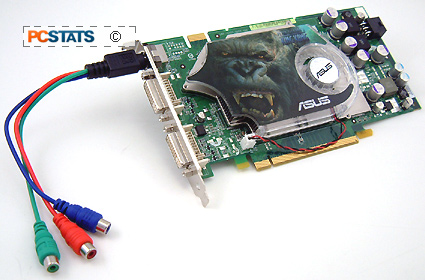High Definition content is the future of entertainment;
heck Sony is betting on HD massively by timing the release of the PlayStation 3
when HD is set to fully explode into the lexicon of techno-geeks! Playing High
Definition content on current generation PCs can bog down the fastest processors
because there is so much more data to handle.  Similar to the need
for DVD accelerators a few years back, nVIDIA PureVideo enables computer users
to view MPEG-2/DVD, H.264 and WMV HD formats without slowing the PC to a
crawl.
Similar to the need
for DVD accelerators a few years back, nVIDIA PureVideo enables computer users
to view MPEG-2/DVD, H.264 and WMV HD formats without slowing the PC to a
crawl.
The PureVideo standard incorporates a hardware accelerator
for the afore mentioned MPEG-2/DVD, H.264 and Microsoft Windows Media HD Video
standards (WMV HD). According to nVIDIA's documentation on PureVideo, the GPU
(GeForce 6 and 7 series GPUs) takes on video decoding tasks from the CPU, and
the end result is smoother, shutter free HD playback. nVIDIA PureVideo also
supports most current and future high definition formats. The system seems to be
built with a good degree of future proofing for upcoming standards - as it
should be.
'H.264' is a standard that describes a next generation
digital video codec which achieves very high data compressions, at a larger
ratio than anything else currently available. H.264 is able to provide quality
video at bit rates that are substantially lower than previous standards like
MPG2, H.263, etc. To decode this much data on the fly without a hardware
accelerator requires a large pool system resources. nVIDIA's GeForce 7 series
supports H.264 hardware acceleration which takes the task of decoding H.264
video off the processor, placing it onto the videocard GPU which is more
efficient at this task. This frees up the CPU resources to perform other
tasks.
High Definition Content Protection (HDCP) encoding is
supported natively by the 'G71' GPU and is built into PureVideo as well. This
means users should have no difficulty playing copy right protected high
definition content on their computers at full resolution when all of this comes
into play. There might not be a need for this at the moment, however Microsoft
Windows Vista will require HDCP enabled hardware to play Blu-Ray/HD-DVD videos.
Computer hardware that does not support HDCP will be limited to playing high
definition content at lower resolutions, or in worse case scenarios, not at
all.
nVidia's
PureVideo is more than just a media accelerator; it also includes features to
improve video picture quality. If you believe the marketing; DVD, cable, and
satellite video provide poor crispness, clearness and smoothness that consumers
are desperate to be "saved from." PureVideo technology applies spatial temporal
de-interlacing to apparently deliver a better image than traditional
de-interlacing can muster. PureVideo also fixes the 3:2 pull down problem that
can arise from 24 fps video being converted to 30 fps for viewing on TVs or
monitors. By recovering the original 24 frame content, PureVideo apparently
allows for a clearer and crisper image.
PureVideo
can also scale videos to any resolution, while maintaining a relatively detailed
picture. This means users can view lower resolution videos at a high resolution
without suffering too much from blocky or blurry pictures.
High Definition CPU
Utilization Tests
To test PureVideo's HD accelerating capabilities, we
decided to play one video through Windows Media Player 10, which was downloaded
from Microsoft's WMV HD Content Showcase. The
Discoverers (IMAX) video is available in both 720P and 1080P formats, and CPU
utilization was monitored through Task Manager to give a general indication of
system load.

Loading the 720P version of the Discoverers
video, CPU usage jumped between 19% and 29%. It seems like nVIDIA might have
improved PureVideo's acceleration a bit as these numbers are better than with
previous generation GeForce 6 and 7 series videocards.

When running the 1080P version of the
Discoverers video, CPU usage is noticeably lower than with previous generation
nVIDIA videocards which is nice. CPU usage here hopped between 25 and 37% which
is very good and leaves plenty of resources for other tasks.
Next up,
overclocking the Geforce 7900GT!
